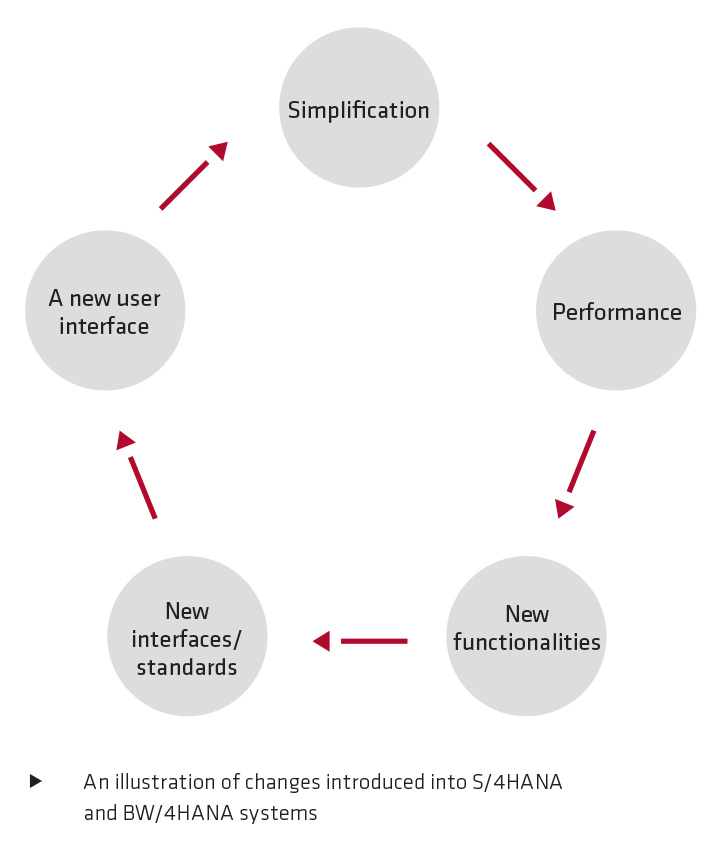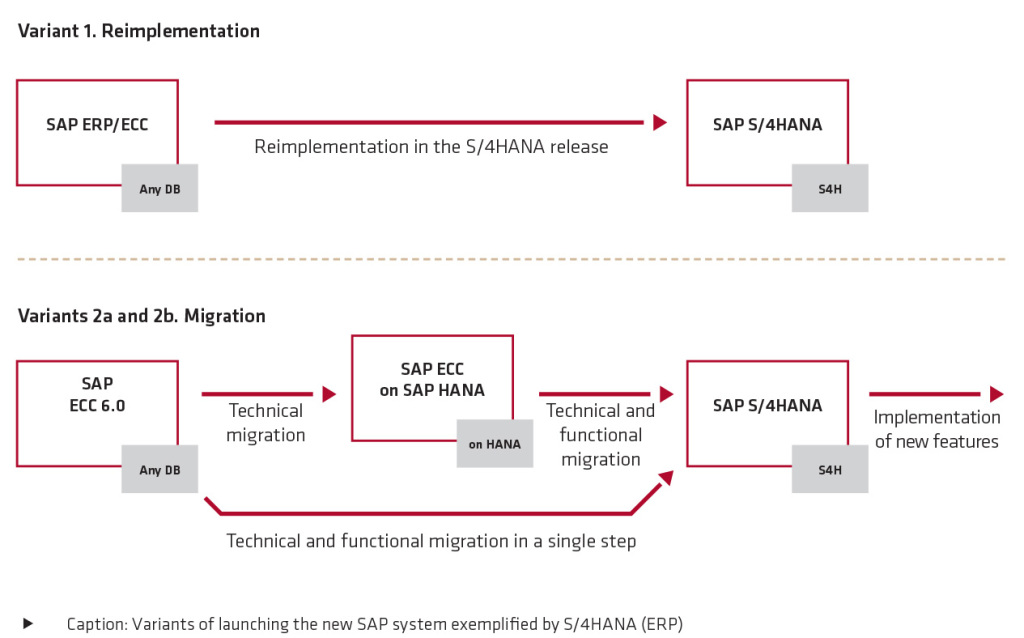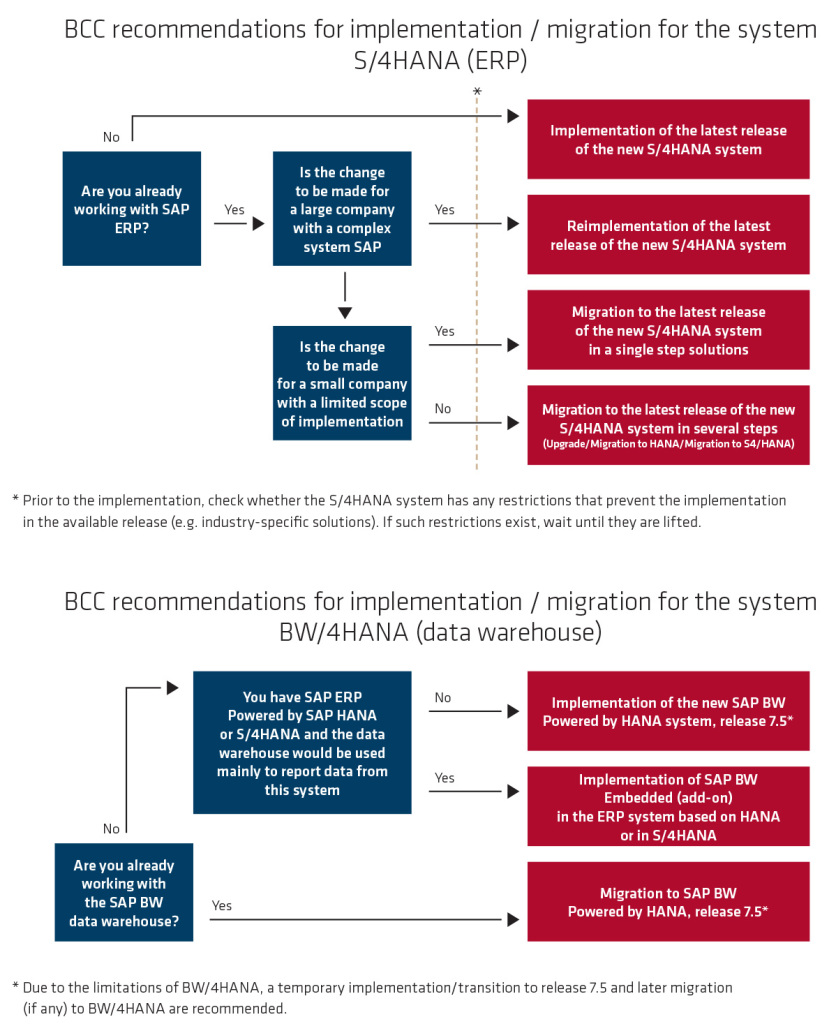Based in Walldorf in Germany, SAP has been surprising its customers with a multitude of innovations for several years. The common denominator of most of them is the SAP HANA platform, which is based on the in-memory database. SAP HANA is based on RAM processing instead of disk-based data storage, and uses data layouts (in columns) applied so far only in the analytical solutions. This platform has become a basis for a wide range of products offered and constantly developed by SAP.
New opportunities, new systems
SAP HANA has enabled the creation of entirely new products and helped refresh the existing ones. The technical migration of SAP NetWeaver systems to the SAP HANA platform has become the simplest and also the quickest way to use the new range of SAP solutions. In this way, each SAP customer can relatively easily migrate to two new products that appeared on the market:
- SAP BW powered by SAP HANA – the SAP BW data warehouse migrated to the SAP HANA platform. Its performance has been dramatically increased (from a hundred to even a thousand times). Complex data flows have been simplified, which contributes to increased end-user satisfaction;
- SAP ERP powered by SAP HANA – the SAP ERP system migrated to the SAP HANA platform.
It ensures better transactional performance and the efficiency of reporting increased many times, and enables reporting directly from the database.
Both products, though revolutionary and relatively easy to implement even for customers with a quite complex SAP system, are only a milestone on the way to a complete reorganization of the SAP portfolio. Suffice it to say that the company from Walldorf not only intends to improve products, but also completely changes the philosophy of their building, using both the new platform SAP HANA, as well as trends present in the whole IT world, such as, for example, the transfer of systems to the cloud (cloud computing), the HTML5 user interface and provision of services instead of software sales (the Software as a Service model).
The result of these far-reaching plans, which are being already carried out, are two new flagship products:
- SAP S/4HANA – a new ERP system, a successor to SAP ERP, with simplified data structures, new modules, integrated with the SAP BPC planning platform, a new reporting system SAP Embedded Analytics and a new user interface based on SAP Fiori (HTML5). It includes both a modernized finance area as well as new logistics;
- SAP BW/4HANA – a new data warehouse from SAP, simplified, with a reduced number of objects, even more efficient and using the capabilities of the SAP HANA platform in 100%. As regards the user interface, it is integrated with the new tool Design Studio (HTML) and Analysis for Office (Excel).
Systems are very different from their predecessors when it comes to architecture (complete rebuilding of data structures) and have a new user interface. They bring freshness into the normally conservative world of large IT systems for business.

Advantages of new solutions
The advantages of S/4HANA and BW/4HANA products that are primarily emphasized by SAP are the simplification of the system and elimination of the baggage of expanding and complex data structures created over the last 30 years. This aspect itself has a positive effect on the properties of new systems. It significantly increases their performance (e.g. when saving a financial document, data are recorded in one central finance table instead of being stored in more than a dozen separate tables, often redundantly).
In addition, the simplification of structures facilitates reporting. There is no need any more to combine data from multiple tables, taking into account exceptions from the combination rules in programs. A simple SQL query can quickly extract the required data from the system at a high level of detail, efficiently and online.
The advantages of S/4HANA and BW/4HANA products that are primarily emphasized by SAP are the simplification of the system and elimination of the baggage of expanding and complex data structures created over the last 30 years.
S/4HANA – a new ERP system
Another advantage of the new architecture is the reversal of the trend of separation into individual SAP systems of different products (e.g. a separate ERP system, a separate demand planning system APO a separate warehouse management system EWM). In the new architecture, many elements can be installed additionally in the ERP S/4HANA system as add-ons. Many of them are also included directly in the standard, which greatly simplifies administration, increases the system reliability and reduces the costs of hardware and configuration of interfaces.
In the case of S/4HANA, the new system includes also new features that were not available in previous versions. An example is a completely new module for cash management, SAP BPC planning integrated with the ERP system, new transactions for reporting line items, taking into account the aggregation of data when a report is being executed.
The SAP S/4HANA has received a completely new user interface in the form of SAP Fiori (HTML5). In the case of S/4HANA, 1610 release (the latest one at the time of writing this article) there are more than 7,000 transactional and analytical applications. In most cases, the user will be able to forget the old SAP GUI interface and switch to completely new transactions, not requiring the installation of special client software (using a browser).
In addition to ready-made applications, SAP delivers SAP HANA Cloud Platform – an environment for creating user applications, both transactional and analytical ones. The creation of analytical applications is particularly easy. They can be built using the browser-based tools such as Query Designer or KPI Modeling Apps.
Finally, the end user of the SAP system has a simple and efficient system for reporting in SAP ERP that is independent of the SAP area/module and allows the user to create tabular and graphic reports and to build analytical dashboards facilitating the review and selection of data that need to be analyzed.
BW/4HANA – a data warehouse
In BW/4HANA, the structure of objects used to model the flow of data has been simplified by reducing the number of possible types of data providers (data storage containers) from nine to three. This makes it easier to work with the system and speeds up the implementation of changes required by business users.
The objects generated in the new data warehouse are displayed as views at the level of the SAP HANA database. Therefore, it is very easy to integrate these data with external tools, e.g. by accessing the database through SQL queries.
Better memory management facilitates in BW/4HANA the division of data by the so-called temperature into hot data (most frequently downloaded to reports), warm (less frequently downloaded to reports) and cold (rarely downloaded). This saves RAM memory (the main resource of the HANA database) and facilitates the creation of truly huge data warehouses.
SAP BW/4HANA has also received refreshed reporting tools. Instead of the portfolio of many SAP BusinessObjects tools, two solutions corresponding to different types of interfaces have been selected and developed. The combination of SAP Lumira and SAP Design Studio has resulted in a great tool for reporting using a browser (SAP Design Studio 2.0). It generates analytical reports/indicators and data entry forms. SAP Analysis for Office has become a universal tool for data formatting and sharing as well as forms for data entry using MS Excel.
Another universal user interface placed in the cloud is the SAP BusinessObjects Cloud platform. The simplification in the portfolio of SAP Business Intelligence reporting tools has long been expected.

Migration paths
Both in the case of the ERP system and the data warehouse for existing customer installations, two variants of launching the new system can be considered. The first variant is a reimplementation, that is a new implementation of SAP S/4HANA or BW/4HANA with the transfer of the required data between systems. This approach is recommended in particular for large enterprises where the SAP system has been used for a long time. The reimplementation will refresh the solutions implemented in the system over the years and will help avoid the transfer of settings that are no longer used.
An alternative is the migration (the second variant) that allows the existing system to be migrated to the new SAP product. This solution is particularly recommended for medium-sized and smaller companies with regard to the ERP system and for all enterprises for the data warehouse. This variant can be divided into stages to simplify the quite complicated migration project. The first step may be the technical replacement of a database, that is a migration to the “powered by SAP HANA” solution. In the second step, an application and technical migration to the new data structures and tools of S/4HANA or BW/4HANA systems can be carried out. After the migration, new features that are available only in the new system can be launched.

A fly in the ointment
Although the dynamic development of products brings the desired changes, from the user’s viewpoint it can also give rise to a number of challenges. For example, in 2016, SAP introduced two on-site releases of S/4HANA – 1511 and 1610. The changes between these releases are really big, especially with regard to logistics, the user interface and reporting. With the 1511 release, SAP prepared 300 SAP Fiori applications. For the 1610 release, this number increased to 7,000, with some applications released at the end of the year replacing the “old” ones from the beginning of 2016.
In addition, the whole new system for creating reports directly in the ERP system is available in the latest release only. The customers who have invested in the 1511 release are facing a vision of the costly upgrade to be made immediately after the go-live of the system to the 1610 release.
BW/4HANA does not support the “old" data flow used in SAP BW warehouses before the appearance of the HANA platform. To launch the new system, you need to convert all the flows and data stored in the data warehouse. Despite the tools provided by SAP, it can be a laborious process with many problems occurring during its execution. BW/4HANA does not support planning and this functionality is yet to be added. BW/4HANA no longer contains older reporting tools BEx Analyzer and Web Application Designer, so old reports may be non-migratable and may require reimplementation.
Systems of the future
S/4HANA (ERP) and BW/4HANA (a data warehouse) systems are completely refreshed, modern, efficient and user-friendly products. They will allow SAP to maintain and increase its share in the ERP and Business Intelligence market. Customer can develop further through the effective use of the support of IT systems.
Unfortunately, the market pressure has forced a somewhat premature debut of new SAP solutions on the market, which seems to be lately a standard in the industry. The initial versions were not thoroughly tested and are being replaced with the next ones in which SAP makes subsequent changes. While as far as ERP (S/4HANA) is concerned, it seems that the system is mature enough for implementation – both in the finance and supply chain area, the development stage of the BW/4HANA data warehouse is still too early to recommend its implementation for most companies. The situation is dynamic and a lot can change in a year or two. To facilitate decision-making for our customers, we have prepared BCC’s recommendations regarding the migration to the latest SAP solutions. We will be pleased to follow this path with you.

10 or even 1,000 times faster: migration of SAP BW to SAP HANA
A large Polish logistics and transport company with one of the largest SAP data warehouses, in collaboration with BCC, has implemented a project of migrating its reporting environment based on the SAP BW data warehouse to the SAP HANA platform. As a result of the project, the performance of the SAP BW system regarding reporting has increased 10 or even 1,000 times (in some cases). Faster and more frequent updating of analytical data and greater employee self-service capabilities in the reporting area have helped change the approach to reporting and analyze data in a different, new perspective. Additionally, the costs of administering a data warehouse have been significantly reduced.
The month-end closing time in finance reduced by half: migration of SAP ERP to SAP HANA
A leader of the meat industry – the Sokołów Group – has migrated the SAP ERP system to the SAP HANA platform as the first company in Poland and one of the first enterprises in Europe.
After the migration of SAP Business Suite to the SAP HANA platform, the speed of loading data and generating reports directly from SAP increased even a thousand times. Faster access to actual data translates into more comfort and a better quality of work for both business analysts and other employees in finance, accounting, procurement and customer service management areas. Both of these groups can also create business reports without having to involve the IT department. The performance restrictions in the creation of ad hoc reports have been eliminated. The data retrieved from the SAP ERP system can be refreshed more often. The processing of logistics transactions has become smoother and the execution time of the month-end closing functions in finance has been reduced by more than half.
The total cost of ownership of the IT infrastructure has been simplified and lowered. The database has been reduced from approximately 2.5 TB (before migration) to less than 600 GB. The system management and backup procedures have been simplified.
S/4HANA in an international corporation
A pharmaceutical manufacturer, based in the United Kingdom, has decided to implement a new ERP system from SAP: S/4HANA. Currently, in cooperation with BCC (now All for One Poland), a project of creating a corporate SAP template and implementing it in the company’s headquarters is underway. The system will cover a wide functional scope, including finance and controlling, materials management and production planning, quality management, sales and distribution as well as warehouse management (EWM). Ultimately, the solution will be rolled out to the other subsidiaries of the company in other European countries.
S/4HANA and SAP SuccessFactors in a retail chain
Yet another way has been chosen by a Polish customer of BCC, a large retail chain that employs over 20 thousand people. It has been working with the new ERP system – S/4HANA in finance and controlling – since early 2017. Users access the system via an intuitive and ergonomic SAP Fiori interface. In addition, bearing in mind the importance of human capital management in a distributed organization, the company has also decided to implement SAP SuccessFactors, a solution available in the SaaS model. The system will help manage a large team using the Employee Central module and will enable line managers to flexibly schedule working time (All for One E-time on HANA Cloud Platform, a proprietary application).

